I have a selenium-webdriver-di.cs file like this:
using TechTalk.SpecFlow;
using OpenQA.Selenium.Chrome;
using OpenQA.Selenium;
using BoDi;
using System;
using System.IO;
using System.Text;
using System.Collections.Generic;
public class WebDriverHooks
{
private readonly IObjectContainer container;
private static Dictionary<string, ChromeDriver> drivers = new Dictionary<string, ChromeDriver>();
private ScenarioContext _scenarioContext;
private FeatureContext _featureContext;
public WebDriverHooks(IObjectContainer container, ScenarioContext scenarioContext, FeatureContext featureContext)
{
this.container = container;
_scenarioContext = scenarioContext;
_featureContext = featureContext;
}
[BeforeFeature]
public static void CreateWebDriver(FeatureContext featureContext)
{
Console.WriteLine("BeforeFeature");
var chromeOptions = new ChromeOptions();
chromeOptions.AddArguments("--window-size=1920,1080");
drivers[featureContext.FeatureInfo.Title] = new ChromeDriver(chromeOptions);
}
[BeforeScenario]
public void InjectWebDriver(FeatureContext featureContext)
{
if (!featureContext.ContainsKey("driver"))
{
featureContext.Add("driver", drivers[featureContext.FeatureInfo.Title]);
}
}
[AfterFeature]
public static void DeleteWebDriver(FeatureContext featureContext)
{
((IWebDriver)featureContext["driver"]).Close();
((IWebDriver)featureContext["driver"]).Quit();
}
And then in each of my .cs files that contains the step definitions, I have constructors like this:
using System;
using TechTalk.SpecFlow;
using NUnit.Framework;
using OpenQA.Selenium;
using System.Collections.Generic;
using PfizerWorld2019.CommunityCreationTestAutomation.SeleniumUtils;
using System.Threading;
using System.IO;
namespace PfizerWorld2019
{
[Binding]
public class SharePointListAssets
{
private readonly IWebDriver driver;
public SharePointListAssets(FeatureContext featureContext)
{
this.driver = (IWebDriver)featureContext["driver"];
}
}
}
And then I'm using the driver variable in all the functions of the class. Lastly I have a file that I called Assembly.cs, where I put this for NUnit fixture level parallelization:
using NUnit.Framework;
[assembly: Parallelizable(ParallelScope.Fixtures)]
Which in SpecFlow's terms means parallelization on the Feature level(1 .feature file = 1 Nunit Test = 1 Nunit Fixture)
If I run my tests serially, they work fine.
But if I run 2 tests in parallel, any two tests, always something funny happens. For example: the first Chromedriver window tries to click an element and it clicks it if and only when the second Chromedriver window (that is running a different test) renders the exact same part of the website. But it sends the click to the correct window (the first one).
I have tried:
- To use the
IObjectContainerinterface and then docontainers[featureContext.FeatureInfo.Title].RegisterInstanceAs<IWebDriver>(drivers[featureContext.FeatureInfo.Title])in theInjectWebDriverfunction - To use
Thread.CurrentThread.ToString()instead offeatureContext.FeatureInfo.Titlefor indexing - To do
featureContext.Add(featureContext.FeatureInfo.Title + "driver", new ChromeDriver(chromeOptions)instead ofdrivers[featureContext.FeatureInfo.Title] = new ChromeDriver(chromeOptions);in theCreateWebDriverfunction.
I just do not understand what allows this "sharing". Since FeatureContext is used for everything related to driver spawning and destruction, how can two chromedrivers talk with each other?
Update: I tried the driver initialization & sharing like this:
[BeforeFeature]
public static void CreateWebDriver(FeatureContext featureContext)
{
var chromeOptions = new ChromeOptions();
chromeOptions.AddArguments("--window-size=1920,1080");
chromeOptions.AddArguments("--user-data-dir=C:/ChromeProfiles/Profile" + uniqueIndex);
WebdriverSafeSharing.setWebDriver(TestContext.CurrentContext.WorkerId, new ChromeDriver(chromeOptions));
}
and I made a webdriver-safe-sharing.cs file like this:
class WebdriverSafeSharing
{
private static Dictionary<string, IWebDriver> webdrivers = new Dictionary<string, IWebDriver>();
public static void setWebDriver(string driver_identification, IWebDriver driver)
{
webdrivers[driver_identification] = driver;
}
public static IWebDriver getWebDriver(string driver_identification)
{
return webdrivers[driver_identification];
}
}
and then in each step definition function, I'm just calling WebdriverSafeSharing.getWebDriver(TestContext.CurrentContext.WorkerId) without any involvement of the FeatureContext. And I'm still getting the same issue. Notice how I'm doing chromeOptions.AddArguments("--user-data-dir=C:/ChromeProfiles/Profile" + uniqueIndex); because I'm also starting to not trust that chromedriver itself is thread safe. But even that did not help.
Update 2: It tried an even more paranoid webdriver-safe-sharing.cs class:
class WebdriverSafeSharing
{
private static readonly Dictionary<string, ThreadLocal<IWebDriver>> webdrivers = new Dictionary<string, ThreadLocal<IWebDriver>>();
private static int port = 7000;
public static void setWebDriver(string driver_identification)
{
lock (webdrivers)
{
ChromeDriverService service = ChromeDriverService.CreateDefaultService();
service.Port = port;
var chromeOptions = new ChromeOptions();
chromeOptions.AddArguments("--window-size=1920,1080");
ThreadLocal<IWebDriver> driver =
new ThreadLocal<IWebDriver>(() =>
{
return new ChromeDriver(service, chromeOptions);
});
webdrivers[driver_identification] = driver;
port += 1;
Thread.Sleep(1000);
}
}
public static IWebDriver getWebDriver(string driver_identification)
{
return webdrivers[driver_identification].Value;
}
It has a lock, a Threadlocal and unique port. It still does not work. Exact same issues.
Update 3: If I run two separate Visual Studio instances and I run 1 test for each, it works. Or by having two identical projects run side by side

and then selecting to run the tests in parallel:
